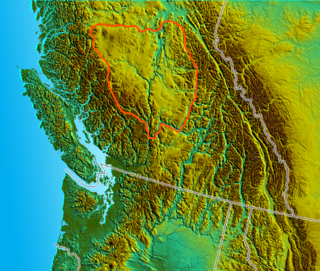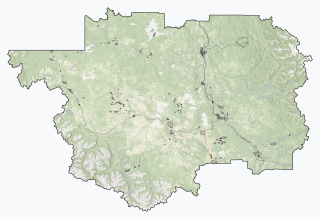Related Research Articles

Lillooet, formerly Cayoosh Flat, is a community on the Fraser River in British Columbia, Canada, about 240 km (150 mi) up the British Columbia Railway line from Vancouver. Situated at an intersection of deep gorges in the lee of the Coast Mountains, it has a dry climate with an average of 329.5 mm (12.97 in) of precipitation being recorded annually. Lillooet has a long growing season, and once had prolific market gardens and orchard produce. It often vies with Lytton and Osoyoos for the title of "Canada's Hot Spot" on a daily basis in summer.

The Cariboo is an intermontane region of British Columbia, Canada, centered on a plateau stretching from Fraser Canyon to the Cariboo Mountains. The name is a reference to the caribou that were once abundant in the region.

The Cariboo Regional District spans the Cities and Districts of Quesnel, Williams Lake, 100 Mile House, and Wells in the Central Interior of British Columbia.

The Cariboo Gold Rush was a gold rush in the Colony of British Columbia, which later joined the Canadian province of British Columbia. The first gold discovery was made at Hills Bar in 1858, followed by more strikes in 1859 on the Horsefly River, and on Keithley Creek and Antler Creek in 1860. The actual rush did not begin until 1861, when these discoveries were widely publicized. By 1865, following the strikes along Williams Creek, the rush was in full swing.
Cariboo River Provincial Park is a provincial park in British Columbia, Canada, located between Barkerville and Likely in the upper Cariboo River basin.

Likely is a community in British Columbia, Canada. It is located in the Cariboo region of the province, and is situated where the west arm of Quesnel Lake empties into the Quesnel River. Roads from Likely lead southwest to Williams Lake, northwest to Quesnel, south to Horsefly, and north to Barkerville. Likely is in the Quesnel Highland, a transition zone between the Cariboo Plateau and the Cariboo Mountains.

Soda Creek is a rural subdivision 38 km north of Williams Lake in British Columbia, Canada. Located on the east bank of the Fraser River, Soda Creek was originally the home of the Xat'sull First Nation. Soda Creek Indian Reserve No. 1 is located on the left (E) bank of the Fraser River, one mile south of the Soda Creek BCR (CN) station, 431.10 ha. 52°19′00″N122°16′00″W
The Williams Lake First Nation is a First Nations government of the Secwepemc (Shuswap) Nation, located in the Cariboo region of the Central Interior region of the Canadian province of British Columbia, at the city of Williams Lake. It was created when the government of the then-Colony of British Columbia established an Indian Reserve system in the 1860s. It is a member government of the Northern Shuswap Tribal Council. Its main Indian Reserve is Williams Lake Indian Reserve No. 1, a.k.a. "Sugarcane" or "The Cane" or "SCB".
150 Mile House is an unincorporated community of 893 people in the Cariboo region of British Columbia. It is located 15 km (9 mi) southeast of Williams Lake on Highway 97.
Horsefly, formerly known as Harper's Camp, is an unincorporated community in the Cariboo region of British Columbia, Canada. It is located between the Cariboo Mountains and Quesnel Lake.
Foster Bar, originally known as Foster's Bar, is a gold-bearing sandbar in the Fraser Canyon of British Columbia, Canada as well as the name used for the surrounding locality, which includes Nesikep Indian Reserve 6 and Nesikep Indian Reserve 6A of the Cayoose Creek First Nation of the St'at'imc people and Lytton Indian Reserves Nos. 6A and 5B and Seah Indian Reserve No. 5 of the Lytton First Nation of the Nlaka'pamux people.

Williams Creek is an important historical gold mining creek in the Cariboo goldfields of the Central Interior of British Columbia, entering the Willow River between Barkerville and the town of Wells, which is at the headwaters of the Willow River.
Antler Creek is a creek located in the Cariboo region of British Columbia. The creek was discovered in 1860 by John Rose. The creek was mined and at one time produced $10,000 per day. The Sawmill flat area was considered the richest section. The creek has been drifted, hydraulicked, sluiced and hand mined.
Dragon Creek is a creek located in the Cariboo region of British Columbia. The creek was discovered in the 1860s by a Frenchman nicknamed The Dragon because of his fighting abilities. The creek has been mined using drifting, sluicing, hydraulicking and drilling.
Jack of Clubs Creek is a creek located in the Cariboo region of British Columbia. This creek was discovered in 1861. It was mined and yielded about $450,000 in gold during the early years.
Lowhee Creek is a creek located in the Cariboo region of British Columbia. The creek was discovered in 1861 by Richard Willoughby who struck it rich here in 1861. He named it after a secret society at Yale University. The creek was mined for gold and was productive in the 1860s. The richest ground was where the stream flows into the meadows. This creek has been worked using sluicing, drifting, and hydraulicking.
Mosquito Creek is a creek in the Cariboo region of British Columbia. The creek is a tributary of Willow River. This creek was discovered to be gold bearing in 1861. It has been mined and produced an estimated $3,500,000 in gold.

Keithley Creek is a ghost town located in the Cariboo region of British Columbia. The town is situated near southwest end of Cariboo Lake, north of Quesnel Lake.
The Lillooet Land District is one of the 59 cadastral subdivisions of British Columbia, which were created by the Lands Act of the Colony of British Columbia in 1859, defined as "a territorial division with legally defined boundaries for administrative purposes". The land district's boundaries came to be used as the boundary of the initial Lillooet riding for the provincial Legislature from 1871, when the colony became a province. In addition to use in descriptions of land titles and lot surveys, the Land District was also the basis of the Lillooet Mining District.
Mount Polley, originally Polley Mountain, elevation 1255 m, prominence 271 m, is a low mountain in the Cariboo region of the Central Interior of British Columbia, Canada. It is located just west of the foot of Quesnel Lake between Bootjack and Polley Lakes. The site experienced a dam breach in 2014 at the Mount Polley mine which caused a spill of mine tailings into the nearby lake and creek.
References
- ↑ N.L. Barlee (1980), The Guide to Gold Panning, Revised Second Edition, Second Printing. Canada West Publications., ISBN 0-920164-04-8